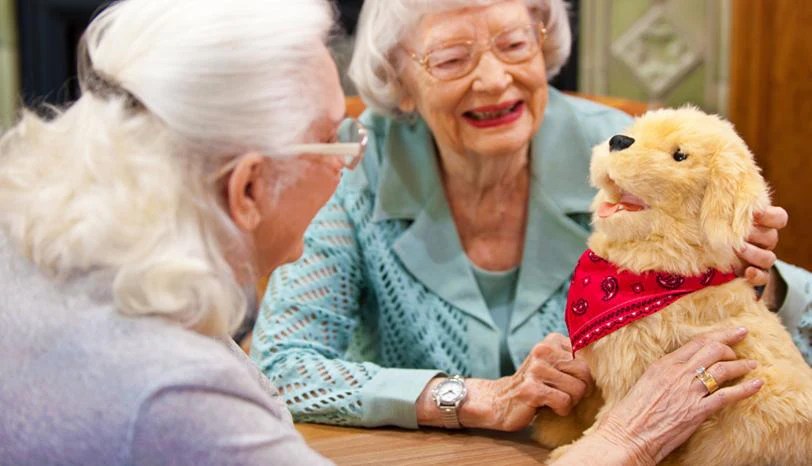In the early 1990s, a researcher at Japan’s National Institute of Advanced Industrial Science and Technology began work on what would become Paro. More than 30 years after its development, the doe-eyed seal pup remains the best-known example of a therapeutic robot for older adults. In 2011, the robot reached the zenith of pop cultural cachet through an unofficial cameo on “The Simpsons.”
Japan has had the age tech robotics market cornered for decades, owing to both an eager embrace of new technology and an aging population. Twenty-nine percent of the nation’s population is 65 and older. An increase in life expectancy is, of course, a net positive, but it can also lead to an erosion in support structure. For decades, robots have long been floated as a way to supplement human shortages in the care market and help older adults feel less alone.
While the United States’ numbers aren’t quite as pronounced, the country is aging. There are currently 62 million Americans aged 65 and older, accounting for 18% of the total population. According to Pew Research, that figure is expected to increase to 84 million, or 23% of the population, by 2054.
While trending older like Japan, the U.S. hasn’t embraced similar technologies as readily. For several years, New York state’s Office for the Aging (NYSOFA) has worked to turn that around. Since 2018, the department has handed out more than 31,500 robot pets to older New Yorkers. Acting Director Greg Olsen says the program was inspired by his then-eight-year-old daughter, who purchased a robotic pet from Amazon.
“When I came home and saw it, I said, ‘This would be amazing to try,’” he said on a Zoom call with TechCrunch. Olsen joined the call from his office, in front of a row of large metal drawers. Dozens of boxes of robot pets rest atop the shelves, displaying three different options: a retriever-like dog, a cat, and red and blue birds.
All three are produced by Ageless Innovations. Founded in 2015 as a Hasbro spinoff, the company specializes in producing robotic companion animals for the aging population through its Joy for All brand. The cat debuted at the end of that year, and the dog arrived in 2016. Both models have common DNA with their counterparts designed by Hasbro-owned FurReal Friends.

The bird is the newest addition to the line. Officially named the “Walker Squawker,” the little robot mounts to assistive walking devices. Like the dogs and cats, the little Squawkers respond to light and touch. They’ll also start singing when they detect that movement has stopped, in a bid to get their owners to use their walking assistance. Olsen notes, however, that the retriever remains the most popular of the bunch, making up around 60% of the total requests.
The same year the NYSOFA began piloting the use of these robots with older New Yorkers, Olsen notes, U.S. Surgeon General Vivek Murthy stated that loneliness is “associated with a reduction in life span similar to that caused by smoking 15 cigarettes a day and even greater than that associated with obesity.” Along with physical concerns, isolation can accelerate cognitive decline in older individuals. The COVID-19 pandemic has significantly exacerbated the issue. Recently, Murthy declared loneliness an epidemic of its own.
Research has demonstrated that pet ownership is an effective method for combating loneliness in older adults. “Pet owners were 36% less likely than non-pet owners to report loneliness, in a model controlling for age, living status (i.e., alone vs. not alone), happy mood, and seasonal residency,” according to one study.
For a variety of reasons, however, pet ownership isn’t always a viable option for older adults. That’s where the robots come in. Given the recent nature of the phenomenon, research into robotic pets is significantly more limited. Studies, however, have pointed to potential benefits, particularly in cases when interaction with humans and animals is limited for health-related reasons.
“Companion pets improved depression and loneliness without risks associated with pharmacological interventions,” a 2022 study on robotic pets notes. “Participants were engaged with their companion pet, providing meaningful activity and positive experiences, especially when COVID-19 restrictions were at its worst, with participants sequestered, and family visitation restricted.”
The study goes on to add that human interaction is still key: “More importantly, conversations between participants, family, and professional caregivers enhanced the therapeutic milieu.”

While robot pets have shown promise in combating loneliness, they’re not a cure unto themselves. Olsen notes that the robotic pet program is one of 21 different partnerships the NYSOFA has with tech companies, including one with Intuition Robotics, which produces ElliQ. The department has handed out nearly 900 of the social robots, which helps users connect to and monitor loved ones. The NYSOFA provides other services to older adults as well, including transportation and phone trees.
The six-year-old robot pets program has been one effective tool for the organization, according to Olsen. He cites a number of stories of clients who have grown attached to their pets, including one woman who told the NYSOFA that they would have to “pry this cat from my dead hands.” Another, according to Olsen, asked to be buried with his robot. Mourners at his service were initially baffled when a muffled barking emerged from inside the casket.

